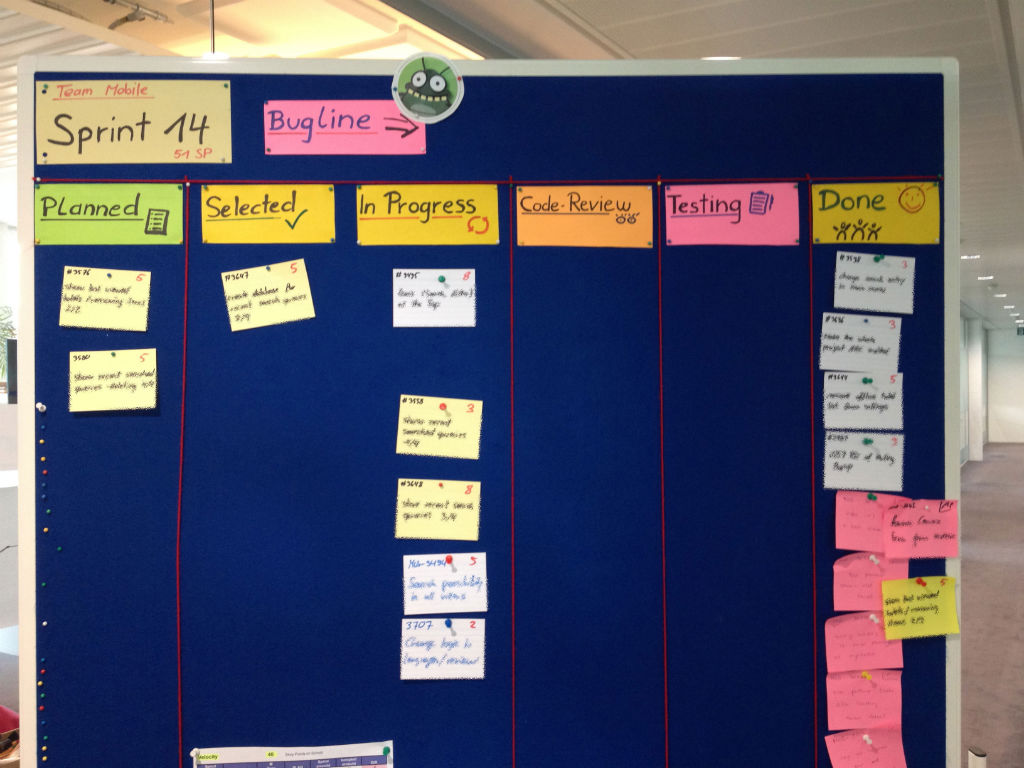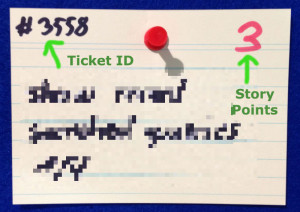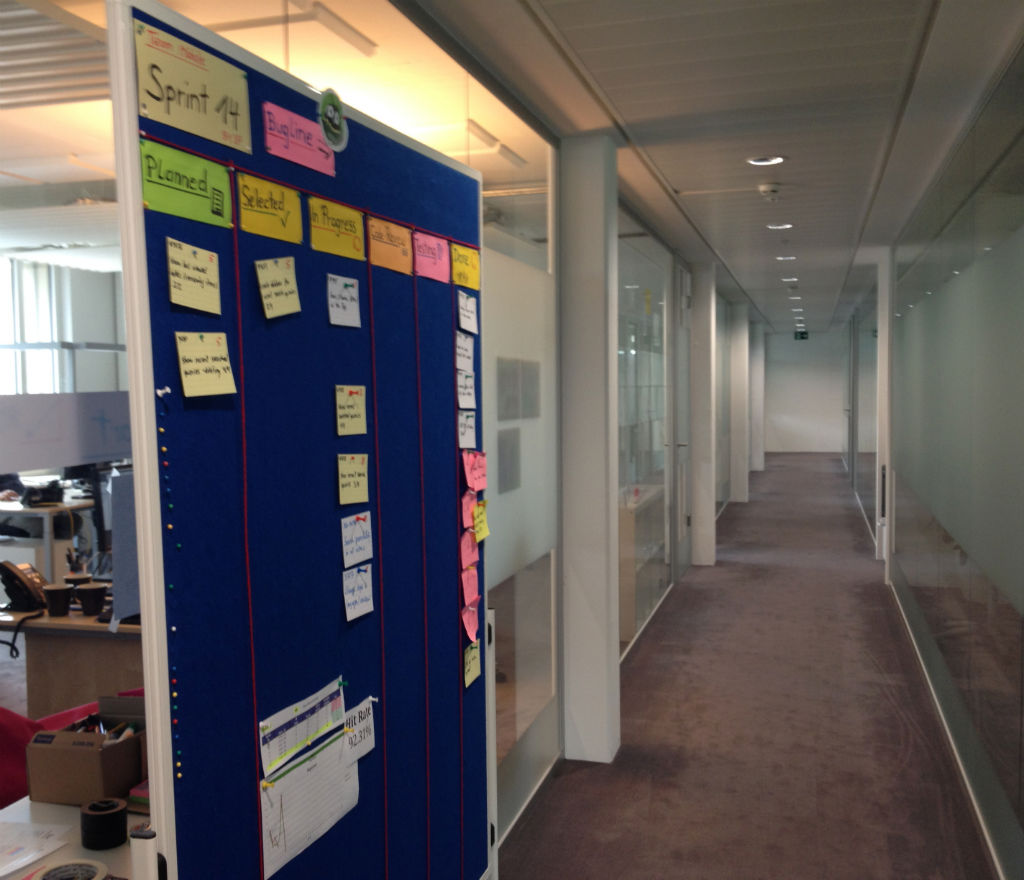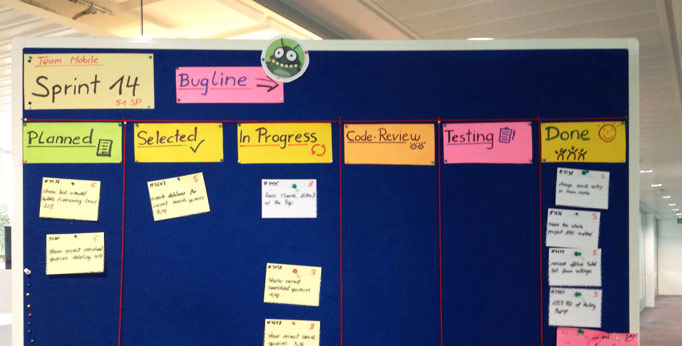In Scrum Teams I used to work always with physical cork boards or whiteboards to visualize the status of a running sprint. Nowadays many companies have distributed teams. Therefore it is quite common to use project management toos like JIRA, Trac or Trello. The first time I was confronted with a distributed team I noticed some interesting details with these tools. In this blog post I want to explain why digital and physical boards do not contradict each other and why it still makes sense to use physical boards.
There is no question about it that distributed teams need a tool to communicate their work. Doesn’t matter if it’s about coding, designing or whatever. Tools like JIRA offer a very good possibility to get organized fast. When I started to work the very first time with these tools in a new team, I tried to understand the Jira board. Apart from the fact that the board was a mess of information I didn’t get an idea where we are standing.
In the daily scrum meeting the team got connected and started talking about everything, except the most important information:
What did I do yesterday?
What will I do today?
Are there any impediments in my way?
Although the team was pretty familiar with scrum, the outcome of the daily meeting wasn’t efficient at all. There was no reference to any story. So it felt like an open morning discussion without any outcome.
Use PM Tools as Real-Time Tools
To achieve a more valuable outcome I came up with the suggestion to set up a physical board and to use Jira as a real time tool. Team members would still continue updating their work on Jira within the day. On the other hand we would use the cork board only for the daily scrum meeting in order to get updated all together by moving items once a day manually.

Focus on your work
The first reaction from some team members was that it is yet another “tool” to maintain. Actually they were right because it is a board we have to update. But the advantage is that in the daily meeting people are focused 100% on the stories and everybody can see when a story is moving. As remote members can’t see the board well, local members just move the items. So in that case people really have to talk about the stories in order to move them.
 As a Scrum Master I started to discover impediments and bottlenecks. I was able to focus all members to the stories. Fun-Factor increased a lot because I noticed that people were enjoying to move items with their hands. It came out that the benefit was not only on Scrum Masters side. Also product managers and developers started to recognize the organizational advantage. Retrospective showed that this solution increased transparency of the team.
As a Scrum Master I started to discover impediments and bottlenecks. I was able to focus all members to the stories. Fun-Factor increased a lot because I noticed that people were enjoying to move items with their hands. It came out that the benefit was not only on Scrum Masters side. Also product managers and developers started to recognize the organizational advantage. Retrospective showed that this solution increased transparency of the team.
I’ve heard arguments of other Scrum Masters that they were trying to setup a similar solution but developers did not use it at all or weren’t just not motivated to use it.
In the beginning it’s the the Scrum Master´s responsibility to show members the advantages of this solution by moderating the new format. Make the board living with cool stuff and colors. It’s not only about the board, it’s also about how you use it.
Physical Boards can change fast
Another advantage of physical boards is that you can change everything very fast. If you need an additional status column or a special bugline, you can put it within a minute. I noticed that many organizations prevent giving teams sufficient rights in digital PM Tools to add/edit/delete schemes, workflows or simple columns due to policy reasons. As a process should fit to the team and product, it’s important that your board reflects the way you really work.
Transparency
People who started to attend the daily meeting understand what the team is talking about because literally everybody talks about what they were really doing. I put the board outside of our office, next to our door in order to show transparency to the company.

Just run the experiment
I wanted to make clear that digital PM tools and physical boards don’t contradict each other. It’s just an additional way of better communication and more transparency. Although I am a big fan of digital solutions, sometimes it’s better to come back to the roots. Brain loves real things.
If you think a physical board could work out in your (remote) team, just give it a try and run the experiment. There is nothing to lose except a little bit of time.
(This solution worked out for a team size of 10 members distributed in 2 locations. )
Leave a star rating for this blog post:



Pingback: Are we bored of boards? – Dear diary,
Synchronize your physical task board with your Scrum or Kanban board in JIRA using Bauer Corkboard addon: https://bauer-information-technology.com/corkboard/
boards get easily synchronized by taking a picture..
Hi Dominic,
You said: “we would use the cork board only for the daily scrum meeting in order to get updated all together by moving items once a day manually.”
Can you please explain more how did you work with Jira and the physical board? Do you have user stories AND tasks in Jira and no tasks on the whiteboard? It really feels like double work. I see the benefit, but my team is fairly new to Scrum, and it doesn’t feel right to show them Jira and a whiteboard if they are only getting familiar with all the concepts. Nevertheless, I would love to hear more how the team was handling the tasks – creating, moving, deleting in both systems (if you still remember :))
Cheers
Indeed physical board has not match. It gives senses of accomplishment when cards are moved to the Done column.
The physical boards can be synced with Jira. There are few possibilities. You can read the information posted here: https://blog.valiantys.com/en/jira-software/sync-physical-agile-board-jira
I hope it will help 🙂